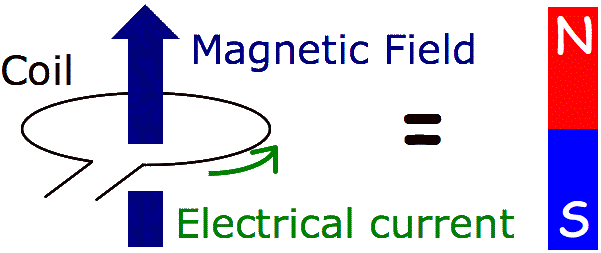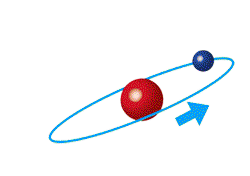Last updated: 26/12/2018
 Magneto-Optics
Magneto-Optics
 Spin Tansport
Spin Tansport
 Magnetoresistance
Magnetoresistance
 Magnetic materials
Magnetic materials
 Magnetic domains
Magnetic domains
 Basic magnetism
Basic magnetism
Spintronics for Kids!
 We have been using magnets all over the places, such as on your fridge, in a moter and a speaker, in a hard disc drive in your computer, and even in your mobile phone! As you know, the magnets attract some metals, Fe, Co and Ni (ferromagnetic metals) for example. The oigin of this force is due to a circular electrical current. When you flow a current in a circular cable as shown in the right figure, this coil behaves like a magnet.
We have been using magnets all over the places, such as on your fridge, in a moter and a speaker, in a hard disc drive in your computer, and even in your mobile phone! As you know, the magnets attract some metals, Fe, Co and Ni (ferromagnetic metals) for example. The oigin of this force is due to a circular electrical current. When you flow a current in a circular cable as shown in the right figure, this coil behaves like a magnet.
 In an atomic scale, similarly, an electron, of which flow is an electrical current, revolves around an atom as well as rotates, showing a spin (see the left figure). This is the origin of the magnetism, which is the most old phenomena based on quantum physics in our history. The orientations of the spins are defined to be either up or down, corresponding to the N- or S-pole in a magnet (right bottom figure).
In an atomic scale, similarly, an electron, of which flow is an electrical current, revolves around an atom as well as rotates, showing a spin (see the left figure). This is the origin of the magnetism, which is the most old phenomena based on quantum physics in our history. The orientations of the spins are defined to be either up or down, corresponding to the N- or S-pole in a magnet (right bottom figure).
 In spintronics, we study on the flow of these spins to contol and engineer the spin polarisation, total population of both up and down spins.
In spintronics, we study on the flow of these spins to contol and engineer the spin polarisation, total population of both up and down spins.